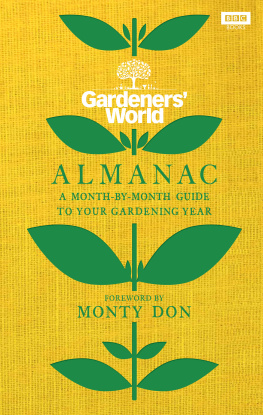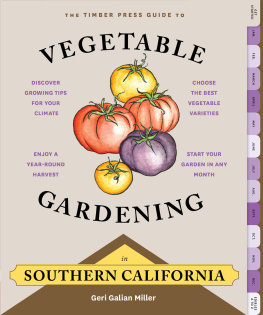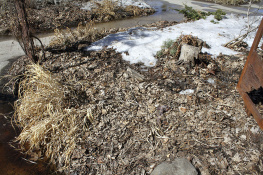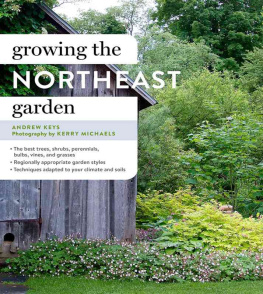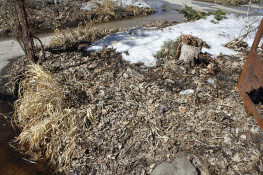
To Louis, in loving memory
Text copyright 2000 by Pat Welsh.
Photographs copyright 2000 by Steven Gunther.
All rights reserved. No part of this book may be reproduced in any form without
written permission from the publisher.
ISBN 978-1-4521-2698-2
The Library of Congress has previously cataloged this title under:
Welsh, Pat.
[Southern California gardening]
Pat Welshs southern California gardening : a month-by-month guide / by Pat Welsh,
p. cm.
Includes bibliographical references and index.
ISBN 0-8118-2214-1 (pb)
I. GardeningCalifornia, Southern. I. Title. II. Title: Southern California gardening.
SB453.2.C3W4541998
635'.09794'9dc21 99-10043
CIP
Designed by Patrick David Barber
Typeset in AGaramond Pro, Frutiger, and Interstate
Chronicle Books LLC
680 Second Street
San Francisco, California 94107
www.chroniclebooks.com
PREFACE
to the Revised Edition
S ince Pat Welshs Southern California Gardening: A Month-by-Month Guide was first published in 1992, tens of thousands of copies have been sold. Many have become dirt-smudged outdoor references, others dog-eared bedside books. Reader inventiveness and suggestions are heartwarming and utilitarian. The greatest compliment is that many a copy has been worn out and is in need of replacement.
This new edition of Pat Welshs Southern California Gardening retains all that gardeners loved and found helpful in the original edition while reflecting the changes that have taken place during the last ten years. You will find here explanations and recommended controls for new plant diseases and exotic pests, such as the giant whitefly, that few people had ever heard of in 1992. Some other pests, including the ash whitefly, that were frustrating gardeners ten years ago are now almost totally controlled by beneficial insects. Also, since the first edition was written, weve been through yet another periodic drought followed by the usual pattern of heavy rains. Todays gardeners need to know what an El Nio is and how to deal with it; theyll find the answers here.
As with the first edition, I recommend many products by generic and trade names, but some garden products are no longer available and have thus been replaced by others. In other cases, the identical product has a new trade name or is manufactured by a different company than before. Organic gardening has increased in importance, a trend reflected in the equipment and supplies discussed in this book. Ive included recommendations of several relatively new products that can help you cope with old problems in innovative, often safer, ways.
Most importantly, Ive added a great deal of information on perennials, including when and how to cut them back. Youll find this advice in every chapter, month by month throughout the year under the general heading Annual and Perennial Flowers. A few plantsgamolepis, for exampleare no longer available, but dozens of new plants, especially perennials and flowering subshrubs, have taken their place. And Ive added several new Quick Tips plus whole sections or boxed features on salvias, botanical geraniums, pelargoniums (those plants known by the common name geranium), lilac, clematis, mesclun, ornamental vegetable gardening, and ornamental grasses, with a clear explanation of how and when to cut them back.
Trends in garden design also affect plant choice. New tract houses are often larger, but their garden spaces are smaller. Lawns are often smaller and more drought resistant than they were in the past, but they remain an important part of gardening. I thus include detailed discussions of the new and improved varieties of lawn grasses while not forgetting to address the care of the older types that are still being grown.
Throughout the nineties, cottage gardens and English-style gardens have been the rage. Now our love affair with Provence and Italy has renewed local interest in what is perhaps a more appropriate model, that of the drought-resistant Mediterranean garden harkening back to our Mission heritage. Bold formal design is also being expressed in new ways. In the twenty-first century I foresee the emergence of an entirely new garden style, a new and innovative formality of design that will provide cheerfulness, excitement, and greater ease of upkeep. All weve learned in the cottage garden can be transferred into a more structured space, combining the greatest formality of design with the greatest informality of planting.
Attention to all these developments has been incorporated into this book. All other material is left intact, though Ive streamlined some of the recommendations to balance their current importance. Ive also added a few brief plant lists to help with specific needs.
Finally, Ive answered the questions most frequently asked when I give talks in Southern California, such as what to do about poor soil ). Many other current questionstoo many to mention hereare handled in detail. An improved and expanded index should make access to the information both quick and easy.
I am grateful to you, the gardeners of Southern California, for taking the first edition of this book into your hearts and making it the local gardeners bible. I hope you will welcome this newly revised and updated version and find it a helpful guide for many years to come.
Happy gardening!
Pat Welsh
Del Mar, California
April 15, 1999
INTRODUCTION
What This Handbook Includes
F or the purposes of this book, Southern California means one large swath of the southernmost third of the state. The map shows that third to be a huge area, most of it sparsely populated. This book addresses the relatively narrow band of heavily populated coastal plains and adjacent inland valleys that begins at the Mexican border, on the south, and extends northward to Gaviota Pass, north of Santa Barbara. Throughout this region, where more than 80 percent of the states population lives, approximately the same wide array of plants is grown.
North of the Gaviota Pass the climate differs from that in Southern California, and a somewhat different array of plants is grown on a schedule thats not the same as ours. Mexico also has a different climate and differing conditions. Even so, many of the plants discussed in this book can also be grown in the central and northern areas of California and in Baja California. Mountains and desert areas are not themselves the subject here, but they are treated in discussions of plants and methods.
Though this book is written specifically for Southern California, parts of it may be of help to gardeners everywhere who have greenhouses. It can also help those who live in Mediterranean or subtropical climates throughout the world who can use it like an encyclopedia of subtropical gardening. (Gardeners in other parts of the world will need to vary the month-by-month schedule to fit their climates. Temperature requirements will apply anywhere, but some specific recommendations, such as the ingredients of planting mixes and names of products, may be altered to fit whats locally available.) Many of the Quick Tips and step-by-step planting and growing directions can be helpful to gardeners anywhere.
Our Unique Schedule for Garden Tasks. Gardening in Southern California offers endless surprises and challenges. It can be a delight, but in order to garden here successfully you have to understand the many problems and solutions that are unique to our region. If you dont have a certain amount of local know-how you wont be able to avoid the pitfalls and reap the rich rewards. Of all the conditions and problems that make gardening in Southern California quite different from anywhere else, theres none more characteristic than our scheduling. Given our climate and our soil, when, what, and how should we plant, propagate, fertilize, and prune?
Next page



